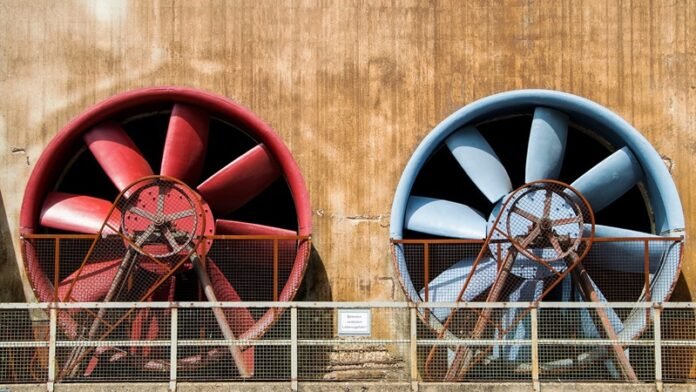Have you ever imagined industrial fans pulsing intelligently to rhythm of your factory humming? Ever toyed with the idea of sitting in the comforts of your office, tweaking fan speeds to optimize both performance and energy efficiency effortlessly? If not, then you’re in for a surprise! This blog will unwrap the symbiotic relationship between industrial fans and smart automation, deep-diving into how this duo improves control and efficiency in manufacturing environments.
Industrial fans are the unsung heroes, silently whirling away to cool machineries, manage airflow, and participating in condensation control. Recently, there’s been a significant shift in the way we handle these heroes. This shift forms the crux of our discussion today, introducing us to the world where industrial fans turn smart through integration with state-of-the-art automation technologies.
In this blog post, we’ll explore what happens when industrial fans meet smart automation. We’ll delve into the advantages of this synergy, discuss a few potential drawbacks, and gage whether your factory is ready for this transformation.
Table of Contents
Untangling the Fan-Automation Connection
Untangling the Fan-Automation Connection” is a fascinating yet complex subject. In today’s technological era, automation has been seamlessly integrated into multiple sectors, including the industrial fan industry. The connection between these two might seem tenuous at first, but upon closer inspection, it becomes clear how instrumental automation has been in revolutionising this industry.
Automation in industrial fans is not just about turning the blades; it’s about creating a more efficient, reliable and safer work environment. With the rise of smart factories, industrial fans have evolved beyond simple air circulation devices. They now play a pivotal role in maintaining optimal operating conditions, essential for productivity and worker welfare.
Imagine a scenario where the fan’s speed adjusts automatically to match the ambient temperature, or the fan can self-diagnose a mechanical issue and alerts maintenance staff before a catastrophic failure. This isn’t science fiction; with automation, it’s a reality.
By embracing automation, industrial fan manufacturers are not just improving their products; they’re reshaping the industry. They’re making workplaces safer, more efficient, and more comfortable. They’re also reducing energy consumption and lowering operational costs.
What is Smart Automation in Industrial Fans?
Smart automation is the integration of advanced technology with traditional industrial fan systems. This symbiosis creates a sophisticated, digitally powered system that automates control over fan speed, timing, and more, offering both convenience and heightened control.
Consider it as a leap from manual to intellectual control of your industrial fans, where data-driven decisions bring in more efficiency and predictability, contributing to climate control, indoor air quality, safety, and energy conservation within the production environment.
Why Choose Automated Industrial Fans?
Choosing automated industrial fans means embracing a more efficient, controlled, and energy-saving way of managing airflow. Smart automation systems can adapt to changing needs, adjust according to environmental factors and even predict maintenance needs, thus providing streamlined operations.
In the age of sustainability and green technology, this intelligent tweak ensures you make an environmental-friendly choice while enhancing overall factory comfort and ensuring the longevity of your machinery.
The Integration Process: How are industrial fans automated?
The journey from an industry-standard fan to a smart one involves adding sensors, amplifiers, and control systems to your existing set up. These connected devices bring in an unprecedented level of control, optimizing fan speeds based on needs, and providing you with real-time insights impacting the efficiency and performance of your production process.
Potential Benefits of Fan Automation
Beyond the lure of convenience, incorporating smart automation offers tangible benefits to manufacturers. Enhanced control, significant energy savings, improved indoor air quality, and reduced strain on machinery are just some gifts this nifty inclusion bestows you with.
The Potential Drawbacks
Like any technology, fan automation does come with challenges, such as higher upfront costs and the need for digital prowess. As always, the question of cybersecurity lurks in the shadows as these systems are only as secure as the networks they’re part of.
Is Your Factory Ready?
There’s no one-size-fits-all answer to this, as the decision to switch depends on multiple factors such as the size of your factory, the age, and type of the existing fan system, and last but not least, your digital readiness.
The Verdict: Is It Time for a Breezy Transition?
Whether to integrate smart automation into your industrial fans is a decision that should be guided by your factory’s needs, environment, and long-term goals. While the upfront costs might deter some, the long-term benefits of increased control, efficiency, and sustainability make it a substantial consideration.
There’s also the undeniable allure of aligning your production process with the future of manufacturing — a future where automation and digital control play leading roles alongside the typical heavy machinery. Weigh your options, make an informed choice and embrace the winds of change as they whoosh their way into the world of industrial fans.








